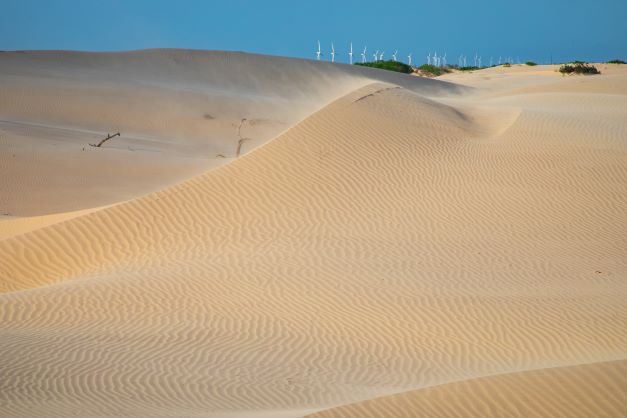Wind Turbines

Wind Energy in the Rio Grande Valley of Texas
Towering turbines and blades to harvest the wind for electricity to power South Texas along a corridor east of U.S. Highway 77 through Willacy County will be within easy view of motorists.
Construction of wind energy farms are concentrated approximately five miles east of Raymondville toward San Perlita and five miles east of Sebastian at the intersection of Farm-to-Market (FM) Road 1081 and FM 507 is underway. The sites feature portable buildings, trucks, earth moving equipment and some cables. Access roads across fields are being built for crews to reach the turbine sites and underground power lines will carry the electricity from the towers to existing utility lines.
Technical Training available in the Rio Grande Valley
Texas State Technical College (TSTC) Harlingen opened its Wind Energy Technology (WET) Program in 2010 to train entry-level technicians for the industry’s workforce along with TSTC West Texas, and a grant from the Governor’s Office allowed TSTC Harlingen and Del Mar College of Corpus Christi to welcome students to WET courses at the Renewable Energy Education Center in Ingleside during August 2011.

As is depicted in hundreds of Western movies, windmills have always been part of the landscape of the American prairie and plains, where they were used to dredge water up from the depths. But in recent years, a new generation of windmills has come on the scene as a major component in the initiative to produce more green power. Research on wind energy began in 1970 at West Texas A&M University, leading to the establishment of the Alternative Energy Institute (AEI) in 1977. The first wind turbine was erected in the state in 1999 at Big Springs. Since then, so-called “wind farms” have sprung up throughout the state, making Texas the leading producer of wind-driven electricity in the United States.
Here in the Rio Grande Valley, prevailing South Easterly winds off the Gulf of Mexico make the region particularly attractive for wind energy development. Beginning initially in Willacy County in the 2010s, wind farming has spread throughout the region. Outside of major cities, it is virtually impossible to drive anywhere in the region without seeing these enormous towers dominating the skyline, forming a new component in the landscape of South Texas.
Listen to the podcast in English - Windturbines
Los molinos de viento, tal como a menudo se ven en muchas películas del Oeste, han sido desde siempre parte del paisaje de las praderas y las llanuras norteamericanas, en las que era necesario extraer agua de las profundidades subterráneas. Sin embargo, en años recientes, una nueva generación de «molinos de viento» ha irrumpido como un componente principal para la producción de energía verde, y también como elemento del paisaje. La investigación sobre la producción de energía eólica se inició en la década de 1970 en el campus del oeste del estado, en la Universidad de Agricultura e Ingeniería Mecánica de Texas (Texas A&M), dando lugar en 1977 a la fundación del Instituto de Energías Alternativas (AEI por sus siglas en inglés). El primer aerogenerador del estado se erigió en 1999 en la localidad texana de Big Spring. Desde entonces, los parques eólicos han proliferado en todo Texas, haciendo del estado el mayor productor de electricidad eólica del país.
Procedentes del Golfo de México, los vientos predominantes del sudeste en El Valle del Río Grande confieren a la región una ubicación atractiva para el desarrollo de esta fuente de energía. La aerogeneración de electricidad comenzó dentro de esta zona en el condado de Willacy durante la década de 2010, y se ha extendido por toda la zona haciendo casi imposible circular fuera de cualquier núcleo urbano sin vislumbrar las enormes construcciones que se recortan contra el cielo sobre el horizonte. Son un nuevo rasgo característico del paisaje del Sur de Texas.
